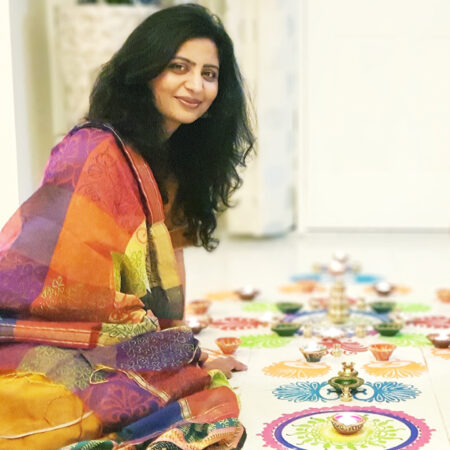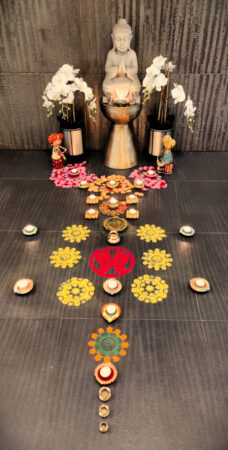By Celebrate Diversity
The timeless elegance of Rangoli

Rangoli, an ancient Indian art form, is more than just a decoration—it’s a vivid celebration of culture and personal expression. With roots stretching back thousands of years, Rangoli has evolved from a traditional practice into a global art form, captivating hearts across continents. Among the artists who have championed this transformation is Kriti Kapoor, an Australian resident who has woven Rangoli into the multicultural fabric of her new homeland.
Rangoli’s global footprint and Kriti Kapoor’s odyssey
As Indian communities migrated around the world, they carried their traditions, including Rangoli. In New Zealand and Australia, Rangoli has found new homes in cultural festivals and community events. Kriti Kapoor, with her deep-rooted passion for this art form, has played a pivotal role in introducing Rangoli to these diverse settings. She has been at the forefront of this movement, using Rangoli as a medium for cultural exchange and community engagement. Her workshops and exhibitions celebrate the rich diversity within Australian cities, bridging gaps between cultures through art.
Kriti Kapoor’s journey with Rangoli began in the heart of India. From the age of four, Rangoli was an integral part of her life. She reminisces with a smile, “Growing up in India, Rangoli was more than just an art form—it was a cherished way of life. My earliest memories are a tapestry of vibrant colours and intricate patterns, especially during the magical festival of Diwali. I would spend hours creating elaborate Rangoli designs, transforming our home into a glowing canvas of diyas and flowers, each stroke a reflection of my own creative spirit.”
As Kriti grew, so did her exploration of Rangoli. Traveling across various Indian states, she immersed herself in the regional variations of the art form. Her designs evolved, reflecting not just traditional patterns but also her imaginative interpretations. This fusion of tradition and creativity became a hallmark of her work.
Upon moving to New Zealand in her late teens, Kriti eagerly shared her Rangoli skills with her new community. The positive response was promising. People from various backgrounds were fascinated by Rangoli and keen to learn about its cultural significance.
Kriti’s journey continued in Australia, where she found a vibrant and multicultural audience eager to explore different cultural expressions. She engaged actively in cultural events and art exhibitions, using Rangoli to connect with people and share her heritage. Her workshops and exhibitions foster inclusivity and creativity, inviting participants of all ages to experience the art form.
A journey through history and evolution

Rangoli’s origins are deeply embedded in the soil of ancient India. Derived from the Sanskrit words ‘Rang’, meaning colour, and ‘Aavalli’, referring to rows, Rangoli was historically crafted on the floors of homes during festivals, auspicious and significant events. These colourful designs were more than mere aesthetics; they symbolised the welcoming of prosperity and good fortune.
Traditionally, Rangoli designs were geometric, embodying intricate patterns that symbolised elements of nature and spirituality. Over centuries, the art form absorbed influences from various regions of India. In South India, Kolam — crafted with rice flour — features complex, interwoven patterns. In Bengal, Alpana, made from rice flour paste, exhibits regional artistic sensibilities. The Madhubani Rangoli of Bihar showcases intricate patterns of nature and animals, while Pookalam from Kerala uses fresh flowers to create colourful patterns. Various region-specific geometric patterns and religious symbols are drawn with coloured powders and diyas in several parts of North and South India. Each style tells a unique story, reflecting the diverse cultural tapestry of India.
Rangoli: a universal canvas
One of Rangoli’s most beautiful aspects is its universal appeal. Rooted in Indian tradition, it remains adaptable to contemporary contexts. Kriti’s work exemplifies this versatility. She has experimented with various materials—coloured powders, rice flour, flower petals, natural elements like leaves and stones and even local elements inspired by the landscape. Her designs also incorporate themes from different global cultures, resonating with a diverse audience. This fusion highlights Rangoli’s beauty and fosters a sense of connection and cultural appreciation.
Bringing Rangoli to the community
Kriti Kapoor’s journey from India to New Zealand and Australia underscores the transformative power of Rangoli. Kriti’s vision extends beyond personal artistry; she aims to make Rangoli accessible to everyone and bridge cultures. She believes art should be inclusive and engaging. Through organising workshops, exhibitions and community events, Kriti creates opportunities for people to connect with Rangoli and explore its creative possibilities.
Her workshops encourage collaboration and inclusivity, celebrating diversity and providing a platform for creative expression. These initiatives foster a sense of community, where individuals can contribute their ideas and creativity, reinforcing the notion that art is a shared experience, celebrate diversity, and build bridges between cultures, illuminating our lives with its vibrant beauty.
Explore the art of Rangoli at the upcoming workshops presented by Celebrate Diversity Inc. and proudly supported by the Brimbank City Council.
Join on:
Saturday September 7 & 14
9:30 am – 12:30 pm
St. Albans Community Centre,
33 Princess St, St Albans
For more information:
Contact: celebratediversity6@gmail.com
Visit: www.celebratediversity.com.au

